Art & Architecture
 |
 |
 |
 |
 |
 |
 |
The Eerie World of AI Imagery
It is irksome today to witness the unhealthy dependence that mankind has developed on technology and artificial intelligence. Modern-day man has become accustomed to forego the effort of learning and laboring hard to acquire a skill or knowledge in order to remain comfortable and lazy.
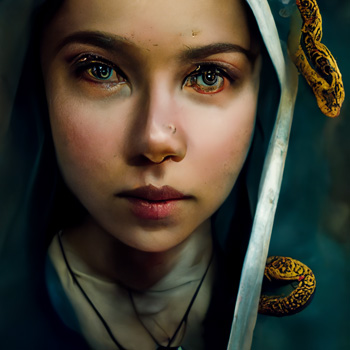 Instead of researching a topic in the library or looking up a word in a dictionary, one simply goes to the computer to “google” the question and gets an instant response, which one then assumes is correct.
Instead of researching a topic in the library or looking up a word in a dictionary, one simply goes to the computer to “google” the question and gets an instant response, which one then assumes is correct.
A new component has entered the picture to further dumb down humanity, if not change it altogether. Artificial Intelligence, a doorway to transhumanism, has been advancing and gaining more and more popularity, especially among youth, who can go to it to write their papers, solve their problems or just chat when they are lonely.
AI robots, chatbots and programmes fascinate this generation who long for “progress” at the cost of their own freedom and development of their talents so that they might give glory to God and Our Lady.
AI art generators
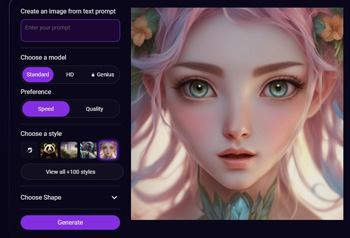 One of the many byproducts of this technological revolution is the rise of art generators. Now, one need only to enter a few prompts into this software and it will effortlessly generate a visual without the need for human intelligences or skills.
One of the many byproducts of this technological revolution is the rise of art generators. Now, one need only to enter a few prompts into this software and it will effortlessly generate a visual without the need for human intelligences or skills.
While this is painful for the actual artist to witness, representing yet another field where man has become superfluous and unneeded – replaced by a machine – it is odious for counter-revolutionary Catholics to see religious art being even further mocked and desecrated.
Today, many Catholics, especially online posters, make use of these AI machines and think that the results are more efficient, less costly and even better than those made by man. However, this is not the case since AI generated images are easy to spot and differentiate from the painstakingly and lovingly-made art of old.
Lifeless Catholic art
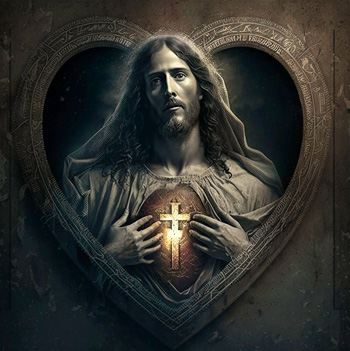 Many suspicious symbols and patterns are present in the AI-generated depictions. This can be attributed to the machine's lack of precision when it comes to details, but in religious art even small details mean a great deal.
Many suspicious symbols and patterns are present in the AI-generated depictions. This can be attributed to the machine's lack of precision when it comes to details, but in religious art even small details mean a great deal.
In addition to this, these generators distort features and make the picture unworthy of depicting anything sacred and perfect. It is common to see the persons represented in such images have more than 5 fingers on a hand or a distorted countenance. Not to mention the fact that these images have lifeless and despairing eyes and disconcerting appearances.
Below, we will compare some religious imagery: Each set presents one from the AI technology and the other made by the hands of men whose aim was to please God first and then man.
Comparison of images
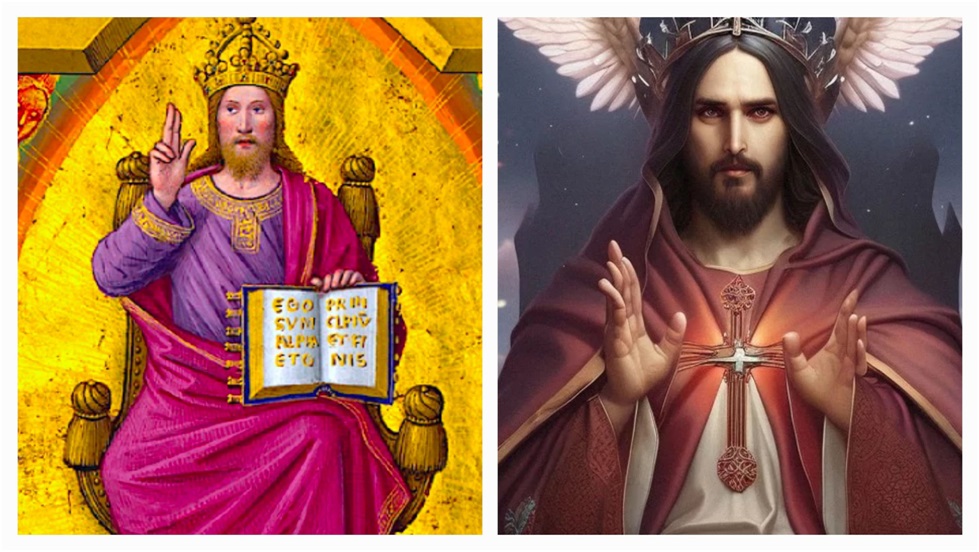
Both of the above figures portray Christ as King. However, one can observe a great difference between the two, disregarding the painting style.
The one on the left draws us to adore and fear our Almighty God. His countenance is grave and majestic, yet his demeanor is gentle and merciful. His hands are calm and composed, reflecting His supernatural state of command and equilibrium. On his head is a bejeweled royal diadem. Seated on a magnificent throne, surrounded by light, He rules with justice and peace.
The other depiction, however, raises confusion rather than admiration. The eyes do not inspire love, but stare at us strangely inviting one to the occult. His contorted fingers stand out eerily giving us the impression of an evil magician ready to play some trick. There is no majesty either in his look or in his demeanor. The crown – or whatever adorns the figure's head – is peculiar and pagan. Overall, the ambience of the AI-generated image is dark, gloomy and inspires anything but the love of God.
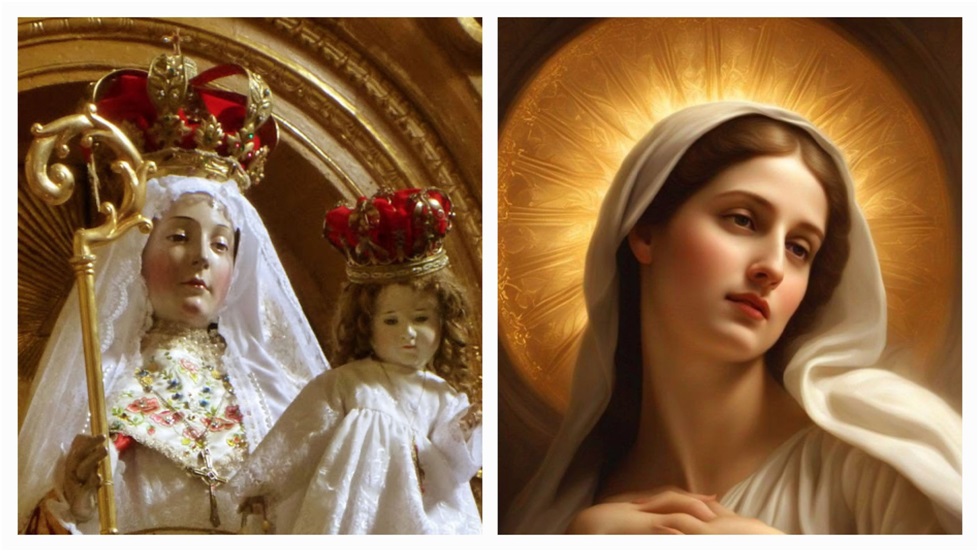
Now, let us look at these two representations of Our Lady.
The one on the left, which seems crafted by angels rather than man, is heavenly and sweet. We find in this image our Good Mother awaiting our prayers and always ready to assist us. Her maternal gaze speaks volumes and her countenance shines with a transcendent beauty that is difficult to describe.
While her mercy consoles us, her majesty is also conspicuous. We feel a tremendous sense of awe as we approach this miraculous statue of Our Lady of Good Success in Quito, Ecuador.
The other illustration, made by AI, presents to us a completely different Mary. Her eyes neither look upward with admiration to God, nor downward with compassion to her children, but rather are turned toward herself, as if imagining how others must be admiring her. She seems more absorbed in herself than in anything or anyone else. Just by looking at these egotistical sensual eyes, we can say that this creation is inappropriate to represent the Mother of God.
The physiognomy of the woman in this second picture shows a sentimental and soft spirit, but without kindness and mercy. One has the idea that this person would be capable of executing any scheme to achieve her earthly ends. If you look closely, you find here also that the fingers are distorted and smudge into one another in an unrealistic way.
One may argue that the images generated by AI are more realistic and better executed than man-made images, but, we respond, this so-called quality does not matter when the portrayals of Our Lord and Our Lady are sentimental and inappropriate.
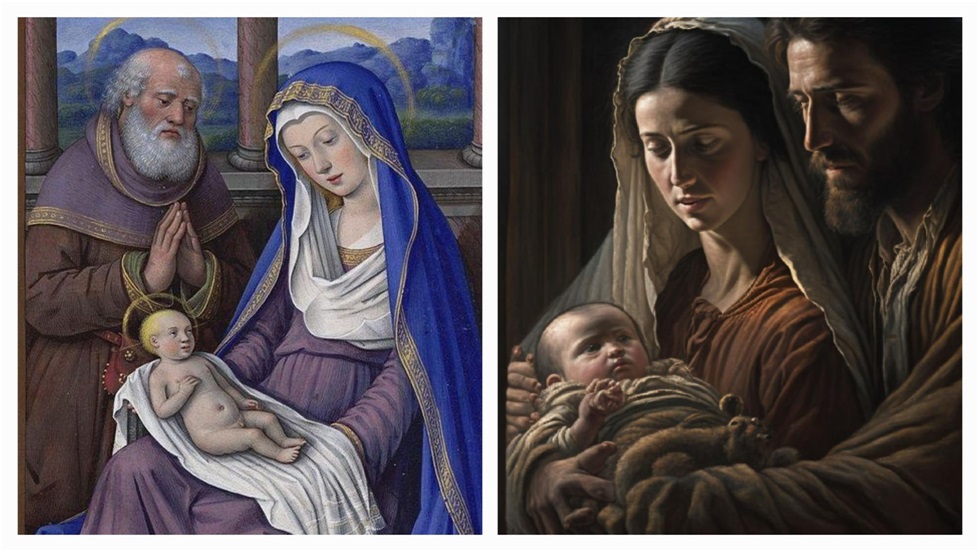
Let us turn now to two Nativity scenes. In this comparison, we can say that the first painting teaches us a valuable lesson as we gaze upon it in quiet admiration. St. Joseph, with his face reflecting reverential fear and awe and his hands folded in worship, encourages the viewer to take the same attitude and join him in adoring the newborn God-Man.
The beautiful face of Our Lady, once again sweet, merciful and at the same time regal, invites us to approach her and her Son, Whom she presents to us as the Savior of mankind. Our Lord's gaze is fixed with an incomprehensible love on His Mother, as if communicating grand mysteries to her, and charges us with the same holy occupation: to look to Our Lady always as the Seat of Wisdom.
Now then, contrast this with the artificially produced picture next to it.
There is a dark sense of sorrow and exhaustion in the whole scene. There is nothing supernatural or transcendent in the faces of Joseph or Mary or the Child Jesus. Nothing induces the viewer to love or fear God. The couple looks concerned and worried, perhaps about financial matters, and even the baby is insipid and sad.
Does the woman have five, six or eight fingers? One cannot be certain of the number or even if these stubs are real fingers. Overall, again, this representation is dark, irreverent and does not move one to the world of the supernatural.
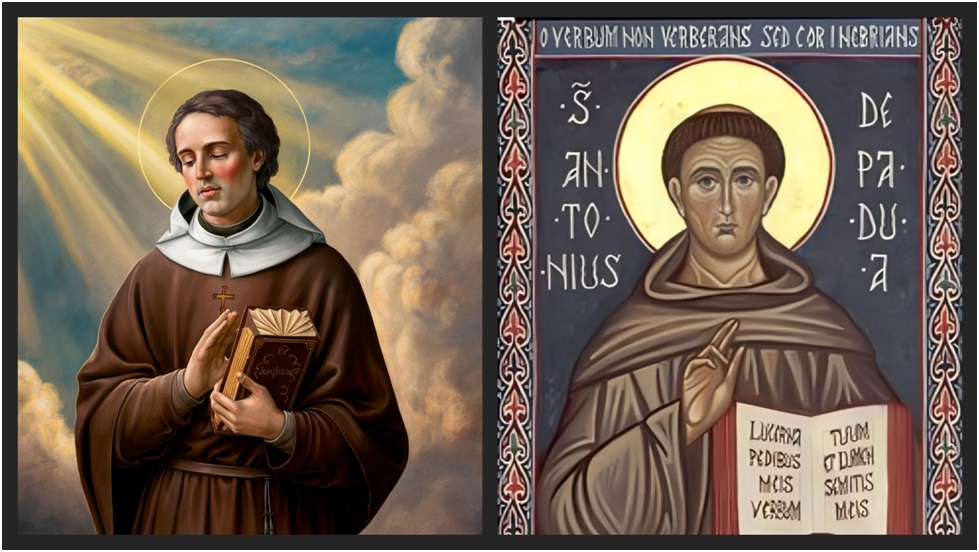
Finally, let us study these pictures of St. Anthony of Padua. The figure at left in the AI image gives us a romantic white heresy notion of the Saint at first glance. A second look shows that something is very wrong. The habit is not Franciscan, the hands are deformed, the soft sentimental face presents a man absorbed in himself. This is not the “hammer of heretics” that the great preacher was known as in his time.
The icon to the right of it, painted by human hands, presents a figure that clearly commands our respect and veneration. This image was made with the intention of inspiring devotion, love and respect for this glorious Saint in the hearts of the faithful. The figure portrays a strong, manly and sacral St. Anthony, who bears the word of God in his heart, hands and on his lips, unlike the soft AI version.
His countenance, grave yet compassionate, is creased with the lines earned from his meritorious labor for the salvation of souls. This one depiction alone teaches us how to compose ourselves if we wish to be the companions of such Saints; it teaches us to value modesty in look and dress, the merit of silence and the importance of meditation. All this and more can be drawn out just by contemplating the icon.
Conclusion
To conclude, paintings that give glory to God and inspire souls should not be crafted by artificial intelligence. It is handing over the sacral and transcendent work to the Devil, so that the evil spirit might present what he would like man to think about Our Lord, Our Lady and the Saints.
In a world that preaches to us to love machines rather than man, and man rather than God, let us not follow these trends that applaud artificial intelligence and disregard human talents given to us by God to use for His glory and for His Holy Church.
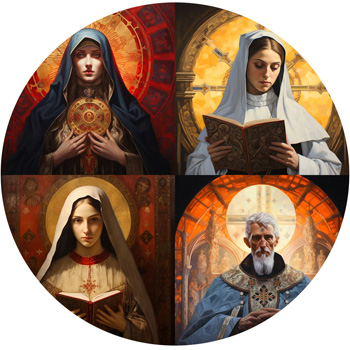


An eerie AI-generated St. Dymphna
A new component has entered the picture to further dumb down humanity, if not change it altogether. Artificial Intelligence, a doorway to transhumanism, has been advancing and gaining more and more popularity, especially among youth, who can go to it to write their papers, solve their problems or just chat when they are lonely.
AI robots, chatbots and programmes fascinate this generation who long for “progress” at the cost of their own freedom and development of their talents so that they might give glory to God and Our Lady.
AI art generators

An online AI Art Generator that creates images in seconds
While this is painful for the actual artist to witness, representing yet another field where man has become superfluous and unneeded – replaced by a machine – it is odious for counter-revolutionary Catholics to see religious art being even further mocked and desecrated.
Today, many Catholics, especially online posters, make use of these AI machines and think that the results are more efficient, less costly and even better than those made by man. However, this is not the case since AI generated images are easy to spot and differentiate from the painstakingly and lovingly-made art of old.
Lifeless Catholic art

An AI-generated Sacred Heart with strange eyes & six fingers...
In addition to this, these generators distort features and make the picture unworthy of depicting anything sacred and perfect. It is common to see the persons represented in such images have more than 5 fingers on a hand or a distorted countenance. Not to mention the fact that these images have lifeless and despairing eyes and disconcerting appearances.
Below, we will compare some religious imagery: Each set presents one from the AI technology and the other made by the hands of men whose aim was to please God first and then man.
Comparison of images

Both of the above figures portray Christ as King. However, one can observe a great difference between the two, disregarding the painting style.
The one on the left draws us to adore and fear our Almighty God. His countenance is grave and majestic, yet his demeanor is gentle and merciful. His hands are calm and composed, reflecting His supernatural state of command and equilibrium. On his head is a bejeweled royal diadem. Seated on a magnificent throne, surrounded by light, He rules with justice and peace.
The other depiction, however, raises confusion rather than admiration. The eyes do not inspire love, but stare at us strangely inviting one to the occult. His contorted fingers stand out eerily giving us the impression of an evil magician ready to play some trick. There is no majesty either in his look or in his demeanor. The crown – or whatever adorns the figure's head – is peculiar and pagan. Overall, the ambience of the AI-generated image is dark, gloomy and inspires anything but the love of God.

Now, let us look at these two representations of Our Lady.
The one on the left, which seems crafted by angels rather than man, is heavenly and sweet. We find in this image our Good Mother awaiting our prayers and always ready to assist us. Her maternal gaze speaks volumes and her countenance shines with a transcendent beauty that is difficult to describe.
While her mercy consoles us, her majesty is also conspicuous. We feel a tremendous sense of awe as we approach this miraculous statue of Our Lady of Good Success in Quito, Ecuador.
The other illustration, made by AI, presents to us a completely different Mary. Her eyes neither look upward with admiration to God, nor downward with compassion to her children, but rather are turned toward herself, as if imagining how others must be admiring her. She seems more absorbed in herself than in anything or anyone else. Just by looking at these egotistical sensual eyes, we can say that this creation is inappropriate to represent the Mother of God.
The physiognomy of the woman in this second picture shows a sentimental and soft spirit, but without kindness and mercy. One has the idea that this person would be capable of executing any scheme to achieve her earthly ends. If you look closely, you find here also that the fingers are distorted and smudge into one another in an unrealistic way.
One may argue that the images generated by AI are more realistic and better executed than man-made images, but, we respond, this so-called quality does not matter when the portrayals of Our Lord and Our Lady are sentimental and inappropriate.

Let us turn now to two Nativity scenes. In this comparison, we can say that the first painting teaches us a valuable lesson as we gaze upon it in quiet admiration. St. Joseph, with his face reflecting reverential fear and awe and his hands folded in worship, encourages the viewer to take the same attitude and join him in adoring the newborn God-Man.
The beautiful face of Our Lady, once again sweet, merciful and at the same time regal, invites us to approach her and her Son, Whom she presents to us as the Savior of mankind. Our Lord's gaze is fixed with an incomprehensible love on His Mother, as if communicating grand mysteries to her, and charges us with the same holy occupation: to look to Our Lady always as the Seat of Wisdom.
Now then, contrast this with the artificially produced picture next to it.
There is a dark sense of sorrow and exhaustion in the whole scene. There is nothing supernatural or transcendent in the faces of Joseph or Mary or the Child Jesus. Nothing induces the viewer to love or fear God. The couple looks concerned and worried, perhaps about financial matters, and even the baby is insipid and sad.
Does the woman have five, six or eight fingers? One cannot be certain of the number or even if these stubs are real fingers. Overall, again, this representation is dark, irreverent and does not move one to the world of the supernatural.

Finally, let us study these pictures of St. Anthony of Padua. The figure at left in the AI image gives us a romantic white heresy notion of the Saint at first glance. A second look shows that something is very wrong. The habit is not Franciscan, the hands are deformed, the soft sentimental face presents a man absorbed in himself. This is not the “hammer of heretics” that the great preacher was known as in his time.
The icon to the right of it, painted by human hands, presents a figure that clearly commands our respect and veneration. This image was made with the intention of inspiring devotion, love and respect for this glorious Saint in the hearts of the faithful. The figure portrays a strong, manly and sacral St. Anthony, who bears the word of God in his heart, hands and on his lips, unlike the soft AI version.
His countenance, grave yet compassionate, is creased with the lines earned from his meritorious labor for the salvation of souls. This one depiction alone teaches us how to compose ourselves if we wish to be the companions of such Saints; it teaches us to value modesty in look and dress, the merit of silence and the importance of meditation. All this and more can be drawn out just by contemplating the icon.
Conclusion
To conclude, paintings that give glory to God and inspire souls should not be crafted by artificial intelligence. It is handing over the sacral and transcendent work to the Devil, so that the evil spirit might present what he would like man to think about Our Lord, Our Lady and the Saints.
In a world that preaches to us to love machines rather than man, and man rather than God, let us not follow these trends that applaud artificial intelligence and disregard human talents given to us by God to use for His glory and for His Holy Church.

AI generated so-called sacred art...

Posted May 24, 2024
______________________
______________________
 Volume I |
 Volume II |
 Volume III |
 Volume IV |
 Volume V |
 Volume VI |
 Volume VII |
 Volume VIII |
 Volume IX |
 Volume XI |
 Special Edition |
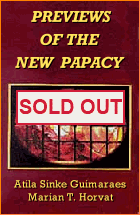 Special Edition |


